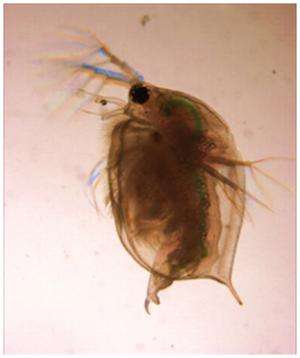Study shows reproductive effects of pesticide exposure span generations

(Phys.org) —North Carolina State University researchers studying aquatic organisms called Daphnia have found that exposure to a chemical pesticide has impacts that span multiple generations – causing the so-called "water fleas" to produce more male offspring, and causing reproductive problems in female offspring.
"This work supports the hypothesis that exposure to some environmental chemicals during sensitive periods of development can cause significant health problems for those organisms later in life – and affect their offspring and, possibly, their offspring's offspring," says Dr. Gerald LeBlanc, a professor of environmental and molecular toxicology at NC State and lead author of a paper on the work. "We were looking at a model organism, identified an important pathway for environmental sex determination, and found that there are chemicals that can hijack that pathway."
Environmental cues normally determine the sex, male or female, of Daphnia offspring, and researchers have been working to understand the mechanisms involved. As part of that work, LeBlanc's team had previously identified a hormone called methyl farnesoate (Mf) that Daphnia produce under certain environmental conditions.
The researchers have now found that the hormone binds with a protein receptor called the Mf receptor, which can regulate gene transcription and appears to be tied to the production of male offspring.
In experiments, the researchers exposed Daphnia to varying levels of an insecticide called pyriproxyfen, which mimics the Mf hormone. The pyriproxyfen exposure resulted in Daphnia producing more male offspring and fewer offspring in total, with higher doses exacerbating both effects.
"At high concentrations, we were getting only male offspring, which is not good," LeBlanc says. "Producing fewer offspring, specifically fewer female offspring, could significantly limit population numbers for Daphnia."
And low exposure concentrations had significant impacts as well. At pyriproxyfen concentrations as low as 71 nanograms per liter, or 71 parts per trillion, the Daphnia would still produce some female offspring. But those females suffered long-term reproductive health effects, producing significantly smaller numbers of offspring – despite the fact that they had not been exposed to pyriproxyfen since birth.
"We now want to know specifically which genes are involved in this sex determination process," LeBlanc says. "And, ecologically, it would be important to know the impact of changes in population dynamics for this species. Daphnia are a keystone species – an important food source for juvenile fish and other organisms."
More information: The paper, "A Transgenerational Endocrine Signaling Pathway in Crustacea," was published April 17 in PLOS ONE: dx.plos.org/10.1371/journal.pone.0061715
Abstract
Background: Environmental signals to maternal organisms can result in developmental alterations in progeny. One such example is environmental sex determination in Branchiopod crustaceans. We previously demonstrated that the hormone methyl farnesoate could orchestrate environmental sex determination in the early embryo to the male phenotype. Presently, we identify a transcription factor that is activated by methyl farnesoate and explore the extent and significance of this transgenerational signaling pathway. Methodology/Principal Findings: Several candidate transcription factors were cloned from the water flea Daphnia pulex and evaluated for activation by methyl farnesoate. One of the factors evaluated, the complex of two bHLH-PAS proteins, dappuMet and SRC, activated a reporter gene in response to methyl farnesoate. Several juvenoid compounds were definitively evaluated for their ability to activate this receptor complex (methyl farnesoate receptor, MfR) in vitro and stimulate male sex determination in vivo. Potency to activate the MfR correlated to potency to stimulate male sex determination of offspring (pyriproxyfen>methyl farnesoate>methoprene, kinoprene). Daphnids were exposed to concentrations of pyriproxyfen and physiologic responses determined over multiple generations. Survivial, growth, and sex of maternal organisms were not affected by pyriproxyfen exposure. Sex ratio among offspring (generation 2) were increasingly skewed in favor of males with increasing pyriproxyfen concentration; while, the number of offspring per brood was progressively reduced. Female generation 2 daphnids were reared to reproductive maturity in the absence of pyriproxyfen. Sex ratios of offspring (generation 3) were not affected in this pyriproxyfen lineage, however, the number of offspring per brood, again, was significantly reduced. Conclusions: Results reveal likely components to a hormone/receptor signaling pathway in a crustacean that orchestrates transgenerational modifications to important population metrics (sex ratios, fecundity of females). A model is provided that describes how these signaling processes can facilitate population sustainability under normal conditions or threaten sustainability when perturbed by environmental chemicals.
Journal information: PLoS ONE
Provided by North Carolina State University












